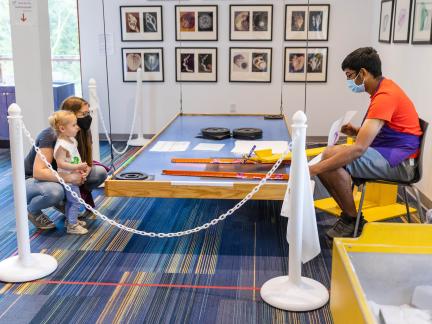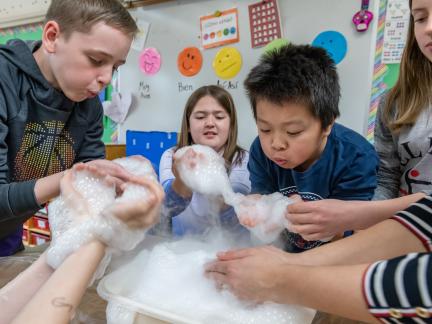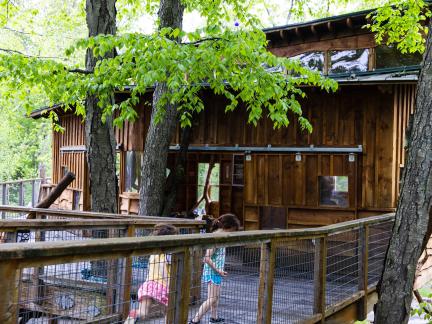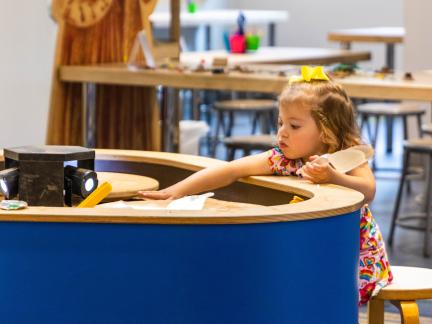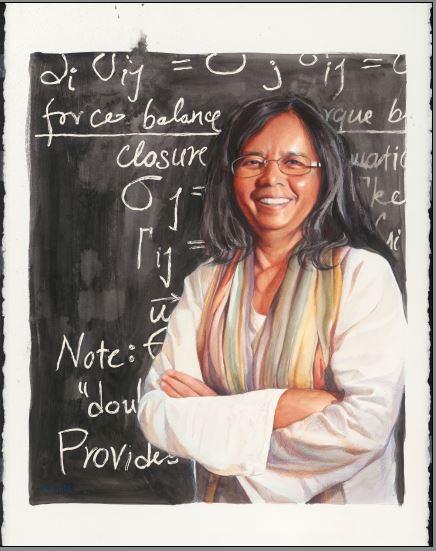Update from our CEO | September 2021
Dear Friend of the Museum,
Let me be clear right up front: I am equally proud of all four of my kids. But as our team at the Museum thinks about the importance of gender representation of STEM professionals to our young visitors, I can’t help wondering why my two sons are both engineers and my two daughters both work in education. Of course, neither field is "better"…but why the gender fault line? As it turns out, my family is not atypical.
Research has shown that there is no inherent difference in math and science ability between girls and boys. And it is a myth that girls aren’t interested in science: through high school, girls and boys take math and science courses in roughly equal numbers, and U.S. Department of Education data shows that girls earn slightly higher grades in those classes. Yet, college women are far less likely to plan a STEM career, according to the College Board—and only 28% of the STEM workforce is women.
The reasons are surely complex, but we do know that the schism starts early. Edutopia cites several studies showing that while young girls are twice as likely to draw men when asked to draw a scientist or mathematician, boys almost universally draw men. It’s worth looking at role models and gender stereotypes—two types of representations that young children can be influenced by. Can kids imagine themselves as a certain kind of grown-up if they have never seen that kind of grown-up?
The Geena Davis Institute on Gender in Media, in partnership with IF/THEN®, an initiative of the Lyda Hill Foundation (and also a funder of our newest exhibit, more on that below), found that in children’s media, for every 15 male characters shown in STEM professions, there is only one female character depicted. A later study of a broader set of media showed male STEM characters outnumbered female characters by nearly two-thirds. For women of color, the representation disparity is even more stark.
The institute’s work also shows that when women are represented, it has an impact: their 2018 study of female STEM professionals found that nearly two-thirds said the female protagonist in the TV show The X-Files served as a role model and increased their confidence to succeed in a male-dominated profession. The researchers dubbed it, “The Scully Effect.”
The gender gap in STEM professions may be in part due to gender stereotypes and the presence of fewer role models in the places young girls might encounter them, such as in the media—or, at their local children’s museum.
Kids notice and absorb lots of information from the world around them. Increasingly, more attention is being paid to the design of learning spaces in all settings and the way it affects kids. In a learning space like Discovery Museum, they are absorbing who they see represented on the walls, in the exhibits, working at the Museum, and visiting the Museum. Do they “see” themselves represented? We need to pay attention to this critical aspect of our learning environment, and we are working to do so.
For many years our Education team has offered a program called “SMART Gals” (Science, Math, Art). SMART Gals highlights the stories of impactful women in STEAM (STEM + Art) as a means to address the representation and role model gaps in kids’ worlds. SMART Gals has long been a popular program and was a good step towards broader representation, but we knew we could do more.
Our newest exhibit, Picture Yourself: Women in STEAM is an exciting step forward to celebrate and highlight local and diverse female scientists and artists, whose work and interests can serve to inspire our young visitors. Through six dynamic and eye-catching portraits paired with colorful and easily digestible information graphics, families will learn about these accomplished women, their research, what they love about their work, and their hobbies and childhood interests. Their stories all have meaningful yet everyday details that make them even more accessible to kids: Bulbul loves to sing, Melissa still has her childhood rock collection, Maureen enjoys art projects, and so forth.
The accompanying graphics also include childhood photos of the scientists—so kids can see that this accomplished professional was once a kid, just like them! They can also learn a little bit about the artists and what they found inspiring about this project. These portraits are pictures of possibilities.
The exhibit is made possible in part by an IF/THEN® Gender Equity Grant, a program created through a partnership between the Association of Science and Technology Centers and IF/THEN®, an initiative of Lyda Hill Philanthropies.
[The portraits shown here are: Professor Piali Sengupta, Sensory Neuroscientist, Professor of Biology at Brandeis University; Professor Bulbul Chakraborty, Condensed Matter Theorist, Professor of Physics at Brandeis University; and Professor Melissa Kosinski-Collins, Structural Biologist, Professor of Biology at Brandeis University. Piali's portrait is oil and acrylic on canvas, by artist Indigo Fox Tree-McGrath of Boston, MA; Bulbul and Meilissa's portraits are watercolor and colored pencil on mixed media board, by artist Katie Runde of Bristol, VT.]
We are celebrating this wonderful exhibit with two events that will give our community a chance to meet and ask questions of this inspiring group of scientists and artists—we hope you will join us! “Picture Yourself: A Virtual Celebration of Women in STEAM” will be held Wednesday, September 29, 6:00 to 7:30pm EDT, via Zoom webinar. The event is geared for children ages 7+ and their caregivers to enjoy together. Registration is required. Kids can submit their questions in advance and if they’d like, ask one live during the event.
You will also have the opportunity meet the scientists and artists at an in-person event at the Museum during public hours, likely on a Saturday in November but stay tuned for the date announcement. Reservations are required to visit the Museum and can be made 10 days in advance (14 days in advance for members).
There is more to come. Through our upcoming Portal to the Public “Meet the Scientists and Engineers” event (learn more below) and other programs, we will continue to expand the ways that we convey the message, “You can be a scientist, an engineer, an artist.” While not all kids will choose to be a scientist—nor should they—we want every kid to see their possibilities as limitless—not constrained by their gender, race, or any other factor.
In other news, work continues apace to prepare our site for the installation of a 326kWh solar array by year end—we will be 100% solar powered in 2022! Reconfiguration of our parking area for the array will also create more and safer parking, new green open space, and a new and safer driveway entrance. Some delays in that work did necessitate the extension of our closure for one week; the Museum will re-open on Tuesday, October 5. Thank you for your support as we undertake this important project. For more on our plan towards carbon neutrality, please see the Discovery Museum Sustainability Plan.
As always, I would much appreciate your thoughts, comments, insights, or questions about our work. Please send them to me at ngordon [at] discoveryacton.org (ngordon[at]discoveryacton[dot]org).
Best,
Neil
P.S. Are you, or do you know, a scientist or engineer? We are currently recruiting for the Fall 2021 cohort of our Portal to the Public Science & Engineering Communication Fellowship program. Practicing STEM professionals are invited to join our Education staff for two professional development workshops to learn effective communication strategies for public outreach and to develop a fun, engaging activity that helps our visitors understand their research. This work will culminate in our "Meet the Scientists and Engineers" event during our First Friday Night Free on Friday, December 3rd. Learn more on our website and please do spread the word about this terrific program.
